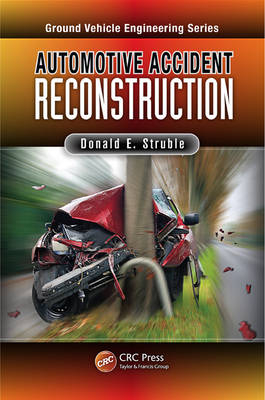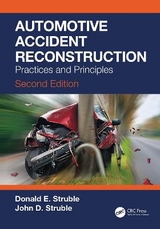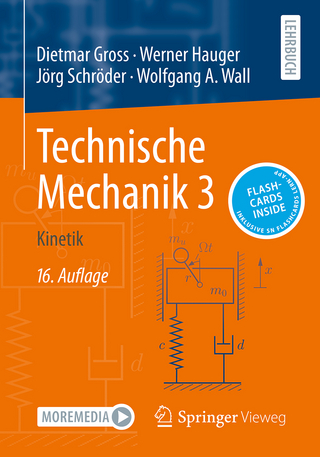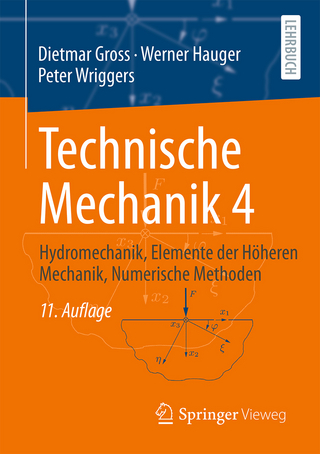
Automotive Accident Reconstruction
Crc Press Inc (Verlag)
978-1-4665-8837-0 (ISBN)
- Titel erscheint in neuer Auflage
- Artikel merken
It discusses the specific requirements of reconstructing rollover crashes, offers background in structural mechanics, and describes how structural mechanics and impact mechanics are applied to automobiles that crash. The text explores the treatment of crush energy when vehicles collide with each other and with fixed objects. It delves into various classes of crashes, and simulation models. The framework of the book starts backward in time, beginning with the analysis of post-crash vehicle motions that occurred without driver control.
Applies time-reverse methods, in a detailed and rigorous way, to vehicle run-out trajectories, utilizing the available physical evidence
Walks the reader through a collection of digital crash test data from public sources, with detailed instructions on how to process and filter the information
Shows the reader how to build spread sheets detailing calculations involving crush energy and vehicle post-crash trajectory characteristics
Contains a comprehensive treatment of crush energy
This text can also serve as a resource for industry professionals, particularly with regard to the underlying physics.
Donald E. Struble holds a BS, MS, and PhD from California Polytechnic State University, Stanford University, and Georgia Institute of Technology, respectively, all in engineering with an emphasis on structuralmechanics. Dr. Struble was assistant professor of aeronautical engineering at Cal Poly, manager of the Research Safety Vehicle program and senior vice president of Engineering and Research at Minicars, Inc., and president of Dynamic Science in Phoenix, Arizona. He is a member of SAE, AAAM, and Sigma Xi, the Scientific Research Society. Formerly senior engineer at Collision Safety Engineering in Phoenix, Arizona, and president of Struble–Welsh Engineering in San Luis Obispo, California, he is now retired.
General Principles
An Exact Science?
Units, Dimensions, Accuracy, Precision, and Significant Figures
Newton's Laws of Motion
Coordinate Systems
Accident Phases
Conservation Laws
Crush Zones
Acceleration, Velocity, and Displacement
Crash Severity Measures
The Concept of Equivalence
Objectives of Accident Reconstruction
Forward-Looking Models (Simulations)
Backward-Looking Methods
References
Tire Models
Rolling Resistance
Longitudinal Force Generation
Lateral Force Generation
Longitudinal and Lateral Forces Together
The Backward-Looking Approach
Effects of Crab Angle
References
Subdividing Noncollision Trajectories with Splines
Introduction
Selecting an Independent Variable
Finding a Smoothing Function
Properties of Splines
Example of Using a Spline for a Trajectory
A Program for Reverse Trajectory Calculation Using Splines
Introduction
Developing Velocity-Time Histories for Vehicle Run-Out Trajectories
Other Variables at Play in Reverse Trajectory Calculations
Vehicle Headings and Yaw Rates
Example Reverse Trajectory Calculation
Yaw Rates
Secondary Impacts with Fixed Objects
Verifying Methods of Analyzing Post-Crash Trajectories
The RICSAC Crash Tests
Documenting the Run-Out Motions
Data Acquisition and Processing Issues
Separation Positions for the RICSAC Run-Out Trajectories
Side Slap Impacts
Secondary Impacts and Controlled Rest
Surface Friction
Sample Validation Run
Results of Reverse Trajectory Validation
References
Time-Distance Studies
Purpose
Perception and Reaction
Constant Acceleration
Example of Constant Acceleration Time-Distance Study
Variable Acceleration
References
Vehicle Data Sources for the Accident Reconstructionist
Introduction
Nomenclature and Terminology
Vehicle Identification Numbers
Vehicle Specifications and Market Data
Vehicle Inertial Properties
Production Change-Overs and Model Runs
Sisters and Clones
Other Information Sources
People Sizes
References
Accident Investigation
Introduction
Information Gathering
Scene Inspection
Vehicle Inspection
Crush Measurement
References
Getting Information from Photographs
Introduction
Photographic Analysis
Mathematical Basis of Photogrammetry
Two-Dimensional Photogrammetry
Camera Reverse Projection Methods
Two-Photograph Camera Reverse Projection
Analytical Reverse Projection
Three-Dimensional Multiple-Image Photogrammetry
References
Filtering Impulse Data
Background and Theory
Analog Filters
Filter Order
Bode Plots
Filter Types
Digital Filters
FIR Filters
IIR Filters
Use of the Z-transform
Example of Finding the Difference Equation from the Transfer Function
Bilinear Transforms
References
Digital Filters for Airbag Applications
Introduction
Example of Digital Filter in Airbag Sensor
References
Obtaining NHTSA Crash Test Data
Contemplating Vehicle Crashes
The Crush Zone
Accelerometer Mount Strategy
Other Measurement Parameters and Transducers
Sign Conventions and Coordinate Systems
Processing NHTSA Crash Test Accelerometer Data
Summary of the Process
Downloading Data from NHTSA's Web Site
Identifying the Accelerometer Channels to be Downloaded
Downloading the Desired Channels
Parsing the Data File
Filtering the Data
References
Processing NHTSA Crash Test Acceleration Data
Background
Integrating the Accelerations
Filtering the Data
Filter( j) Subroutine
Parsing the Data File
NHTFiltr.bas Program Output
Averaging Two Acceleration Channels
Using the NHTSA Signal Browser
References
Analyzing Crash Pulse Data
Data from NHTSA
Repeatability of Digitizing Hardcopy Plots
Effects of Plotted Curve Quality
Accuracy of the Integration Process
Accuracy of the Filtering Process
Effects of Filtering on Acceleration and Velocity Data
Effect of Accelerometer Location on the Crash Pulse
Conclusions
Reference
Downloading and Analyzing NHTSA Load Cell Barrier Data
The Load Cell Barrier Face
Downloading NHTSA Load Cell Barrier Data
Crash Test Data Files
Grouping Load Cell Data Channels
Computational Burden of Load Cell Data Analysis
Aliasing
Example of Load Cell Barrier Data Analysis
Using the NHTSA Load Cell Analysis Software
References
Rollover Forensics
Introduction
Measurements of Severity
Evidence on the Vehicle
Evidence at the Scene
References
Rollover Analysis
Introduction
Use of an Overall Drag Factor
Laying Out the Rollover Trajectory
Setting Up a Reverse Trajectory Spreadsheet
Examining the Yaw and Roll Rates
Scratch Angle Directions
Soil and Curb Trips
References
Vehicle Structure Crash Mechanics
Introduction
Load Paths
Load-Deflection Curves
Energy Absorption
Restitution
Structural Dynamics
Restitution Revisited
Small Car Barrier Crashes
Large Car Barrier Crashes
Small Car/Large Car Comparisons
Narrow Fixed Object Collisions
Vehicle-to-Vehicle Collisions
Large Car Hits Small Car
Barrier Equivalence
Load-Deflection Curves from Crash Tests
Measures of Crash Severity
References
Impact Mechanics
Crash Phase Duration
Degrees of Freedom
Mass, Moment of Inertia, Impulse, and Momentum
General Principles of Impulse-Momentum-Based
Impact Mechanics
Eccentric Collisions and Effective Mass
Using Particle Mass Analysis for Eccentric Collisions
Momentum Conservation Using Each Body as a System
The Planar Impact Mechanics Approach
The Collision Safety Engineering Approach
Methods Utilizing the Conservation of Energy
References
Uniaxial Collisions
Introduction
Conservation of Momentum
Conservation of Energy
Momentum Conservation for Central Collisions
Reference
Assessing the Crush Energy
Introduction
Constant-Stiffness Models
Sample Form Factor Calculation: Half-Sine Wave Crush Profile
Sample Form Factor Calculation: Half-Sine Wave Squared
Crush Profile
Form Factors for Piecewise-Linear Crush Profiles
Sample Form Factor Calculation: Triangular Crush Profile
Constant-Stiffness Crash Plots
Example Constant-Stiffness Crash Plot
Constant-Stiffness Crash Plots for Uniaxial Impacts by Rigid
Moving Barriers
Segment-by-Segment Analysis of Accident Vehicle Crush
Profiles
Constant-Stiffness Crash Plots for Repeated Impacts
Constant Stiffness with Force Saturation
Constant Stiffness Model with Force Saturation, Using Piecewise
Linear Crush Profiles
Constant-Force Model
Constant-Force Model with Piecewise Linear Crush Profiles
Structural Stiffness Parameters: Make or Buy?
References
Measuring Vehicle Crush
Introduction
NASS Protocol
Full-Scale Mapping
Total Station Method
Loose Parts
Other Crush Measurement Issues in Coplanar Crashes
Rollover Roof Deformation Measurements
References
Reconstructing Coplanar Collisions, Including
Energy Dissipation
General Approach
Development of the Governing Equations
The Physical Meaning of Two Roots
Extra Information
Sample Reconstruction
References
Checking the Results in Coplanar Collision Analysis
Introduction
Sample Spreadsheet Calculations
Choice of Roots
Crash Duration
Selecting Which Vehicle is Number 1
Yaw Rate Degradation
Yaw Rates at Impact
Trajectory Data
Vehicle Center of Mass Positions
Impact Configuration Estimate
Vehicle Headings at Impact
Crab Angles at Impact
Approach Angles
Restitution Coefficient
Principal Directions of Force
Energy Conservation
Momentum Conservation
Direction of Momentum Vector
Momentum, Crush Energy, Closing Velocity, and
Impact Velocities
Angular Momentum
Force Balance
Vehicle Inputs
Final Remarks
References
Narrow Fixed-Object Collisions
Introduction
Wooden Utility Poles
Poles that Move
Crush Profiles and Vehicle Crush Energy
Maximum Crush and Impact Speed
Side Impacts
References
Underride/Override Collisions
Introduction
NHTSA Underride Guard Crash Testing
Synectics Bumper Underride Crash Tests
Analyzing Crush in Full-Width and Offset Override Tests
The NHTSA Tests Revisited
More Taurus Underride Tests
Using Load Cell Barrier Information
Shear Energy in Underride Crashes
Reconstructing Ford Taurus Underride Crashes
Reconstructing Honda Accord Underride Crashes
Reconstructing the Plymouth Reliant Underride Crash
Conclusions
References
Simulations and Other Computer Programs
Introduction
CRASH Family of Programs
SMAC Family of Programs
PC-CRASH
Noncollision Simulations
Occupant Models
References
Index
Catalog no. K20381
October 2013
c. 488 pp.
ISBN: 978-1-4665-8837-0
$149.95 / GBP95.00
Shelving Guide/Bookshop Category: Automotive Engineering
Contact Editor: Jonathan Plant
Keywords
Reconstruction
Crush energy
Velocity change (delta-V)
Rollovers
Conservation of energy
Conservation of momentum
Newton's Second Law
Trajectory analysis
Structural stiffness
Restitution
Filters, digital
Planar impacts
Impact velocity
Vehicle crashes
Crash tests
Photogrammetry
Time-reverse
Drag factor
Pole impacts
Underride crashes
| Zusatzinfo | 14 Color Figures - 8 Color Page Insert - follows page 242; Approx. 340 to 360 equations; 18 Tables, black and white; 14 Illustrations, color; 119 Illustrations, black and white |
|---|---|
| Verlagsort | Bosa Roca |
| Sprache | englisch |
| Maße | 156 x 234 mm |
| Gewicht | 839 g |
| Themenwelt | Naturwissenschaften ► Physik / Astronomie ► Mechanik |
| Technik ► Fahrzeugbau / Schiffbau | |
| Technik ► Maschinenbau | |
| Technik ► Umwelttechnik / Biotechnologie | |
| Wirtschaft | |
| ISBN-10 | 1-4665-8837-3 / 1466588373 |
| ISBN-13 | 978-1-4665-8837-0 / 9781466588370 |
| Zustand | Neuware |
| Informationen gemäß Produktsicherheitsverordnung (GPSR) | |
| Haben Sie eine Frage zum Produkt? |
aus dem Bereich



